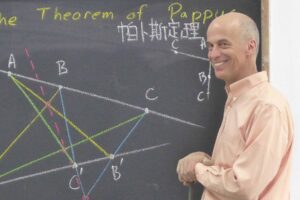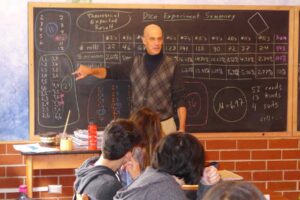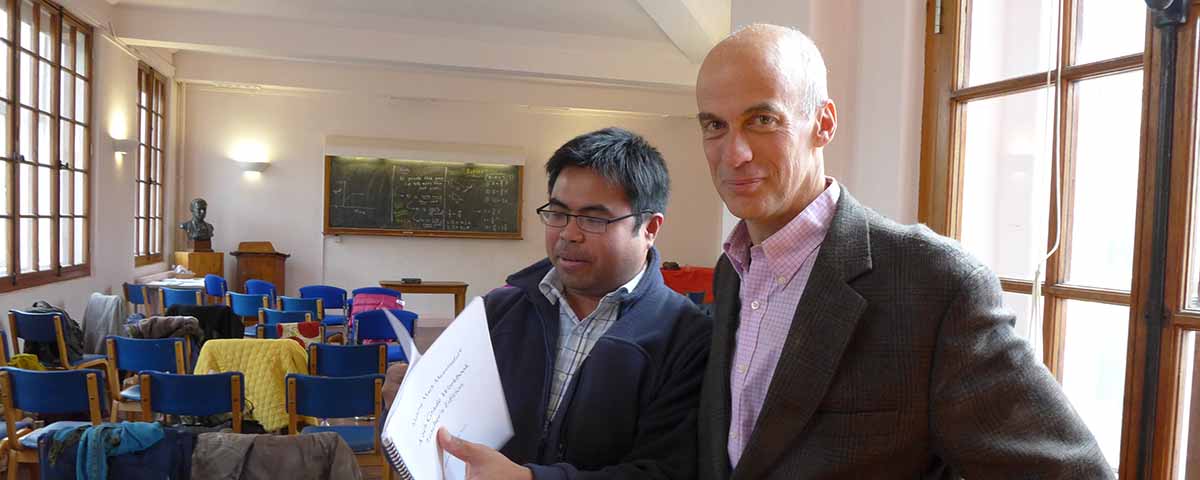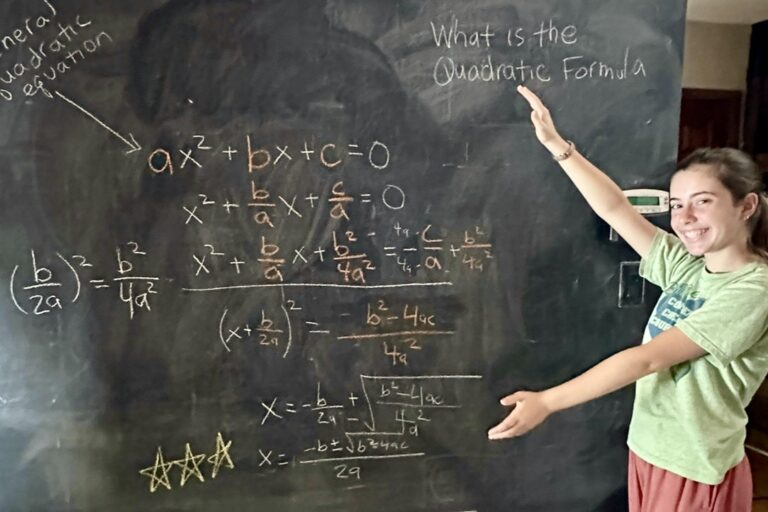This article originally appeared in the Research Institute for Waldorf Education’s Research Bulletin, Fall/Winter 2020 Volume XXV Number 2.
These are Jamie York’s reflections on starting the online Jamie York Academy just months before the COVID-19 pandemic. They came after a year of teaching online. It started as a request from a homeschooler that landed right before the entire world went to online learning. While most schools struggled to respond, Jamie had made this move intentionally, and therefore had some key insights into making it successful.
I’m not a seer who predicted the pandemic and the response that sent a world of teachers into the uncharted waters of web-based learning. Yet many people have asked me how I had the insight to launch an online Math Academy for students (in grades 5-12) just six months before the pandemic hit. I can only say that I had great fortune – at a time, sadly, when so many others have been struck with great misfortune.
Unsurprisingly, the last year of teaching via my computer has been an enormous learning curve for me. Surprisingly, I can now look back and honestly say that it has been my most successful year of teaching in my 35-year career – measuring success largely by my students’ enthusiasm and the development of their thinking. My intent in this brief article is to share some observations and offer modest advice to those who find themselves needing also to teach online. While my experience is with the teaching of mathematics, I believe that most of this also applies to other subject areas.
Let me preface this by saying that I consider myself a Waldorf educator through and through. Both of my children were gifted with a remarkable journey through the grades of Shining Mountain Waldorf School in Boulder, Colorado, where I also taught for 21 years. Karen van Vuuren (my wife and death care visionary) and I shielded our children from all screens right through middle school. It was only in eighth grade that we allowed them computer access, which began with (what for them was) the thrill of taking a computer-aided typing course. Certainly, they witnessed both of their parents interacting frequently with a computer as I wrote my Making Math Meaningful™ curriculum books and Karen edited her documentaries. I know well how media exposure and screen time affects our children developmentally, how it can diminish and deaden their imagination and weaken their thinking capacities and etheric forces if it is left unchecked and if we do not balance it with extra-curricular activities that support social and physical wellness.
Yet, in retrospect, I now realize that my views on technology were dogmatic and limiting. Not all technology is evil – even for children. Using your computer to watch your teacher tell the biography of Julius Caesar is not the same as playing a video game. Solving a math puzzle with a friend via Zoom is not the same as watching an action movie, or surfing the Internet without adult supervision. But there is no doubt that once we open this can of worms, we need to be vigilant. We need to ensure that we protect our young people from the negative aspects of the technological world. It is possible for our children to wisely use technology for the benefit of their education, and at the same time develop in a healthy manner, as long as we simultaneously encourage them to experience the wonders of the world around them.
My first foray into teaching students online (I’d already been offering online teacher workshops for a few years) began last summer at the behest of a European Waldorf homeschool mother. I was very skeptical. How could we possibly teach effectively via a computer screen when genuine human connection is at the heart of a meaningful education? Early on in planning the math academy, it was clear that I needed to structure the math courses differently than I would in a traditional classroom.
I was aware of empirical evidence from studies indicating that most online learning was unsuccessful. Research has shown educational videos – even a video where the students report that it was interesting and clear – often are not effective in teaching a concept. Why is this? What I have come to believe is that as human beings, we are pre-dispositioned to “go to sleep” any time we are in front of a screen for a length of time. This “screen-doziness” happens when our thinking switches off and we become passive observers.
Reflecting on the research, I wondered: How could I possibly create a successful method for teaching math online? To answer this question, I first needed to identify the pitfalls of online learning. For starters, how many of us have heard students of all ages (my own son in college, for one) complain about their uninspiring online classes. What’s behind this common complaint? I’d say two interrelated things: a lack of human connection, and excessive lecturing by the teacher.
So from my recent experience, here is some advice: When teaching online, we need to severely limit the amount of “Teacher Talking Time”. I like to tell myself that, when teaching students online, I have to “snap them awake” every five minutes. Additionally, we need to find multiple ways to have students regularly connect with one another. In an online educational world, students hunger even more to connect with their classmates. Before I share some other tips, let me return to my statement that this past year has been “my most successful year of teaching”, and then I will tell a story. (What Waldorf teacher doesn’t enjoy telling a story?)
When I speak of the success I have found teaching online, I am not claiming that online teaching is superior to in-person teaching, or even that I prefer the former to the latter. Indeed, I miss many things about the traditional classroom. I am simply acknowledging that I saw many reluctant mathophobes emerge as engaged and enthusiastic math-happy students. And I have never before seen my students make such impressive progress in developing their ability to think mathematically. What made this possible? Largely, it was how I structured my program. In a conventional classroom, we can fairly easily float from one activity to another – a bit of lecture or a story, then some artistic activity, some group discussion, perhaps a brief assessment. Teaching in this kind of fluid or spontaneous manner seems much more difficult online. So, I knew I had to consciously build a healthy rhythm into the structure of the week. Two days per week, my students watch a recorded 40-minute lecture. Each lecture was “active” in that it required the students to tackle mental math problems and various practice problems. But to be perfectly honest, if my whole program had only consisted of students watching lectures and working on math homework problems, then my math academy would have been an abysmal failure.
Now, here is my story – an experience with a fifth grade class that I now consider to be one of the greatest highlights in my teaching career. (Warning, there is a bit of math here, but I’ll present it in a way that anyone, with effort, can follow along.) Towards the end of the year, we were in a block I call “The Wonder of Number”. I was asking the students to figure out a way to write a given odd number as the difference of two square numbers. (The square numbers are 1, 4, 9, 16, 25, 36, 49, etc., each one being a whole number times itself.) The exercise was as follows: I give the students an odd number and ask them to write it as the difference of two square numbers.
Example: Find all the ways to express 15 as the difference of two square numbers.
Solution: 15 can be expressed as the difference of two square numbers in two ways: either 16 – 1 or 64 – 49.
You might wonder: how did I expect the students to do this? I figured that they would look at all the square numbers and, through “trial and error”, keep trying different possibilities until they discovered which two square numbers subtract to 15. Fifth graders love this kind of “looking-for-a-needle-in-a-haystack” challenge.
But then something unexpected happened. After one group work session, a parent in the class emailed me to ask: “Don’t you need to review factors before doing this?” I had no idea what she was talking about, so I responded with, “What does this have to do with factors?” It slowly came to light that these fifth graders had discovered something completely new – a connection between the factors of 15 and the ways that 15 could be written as the difference of two square numbers! (I’ll leave it to you to try and determine their method.) They had discovered a sophisticated theorem that I did not know existed! They were so proud and felt so empowered! I am convinced that this was made possible because I created the time and space for them to do real mathematics in a group of their peers.
Group work is the “heart and soul” of my program. This is what the students are longing for – connection with their peers. Twice per week my students get together in small groups and engage in meaningful learning – working on math puzzles, solving problems, and discovering mathematical properties – all of this without the involvement (albeit some supervision) of adults. Never before have my students struggled so much, or discovered so much. Before teaching online, I never felt the need to have my students work so intensively in groups. This group work, I believe, has been the key to my success.
Additionally, there were a couple of surprises for me with teaching online. The first is that it is actually possible for students to experience meaningful, human connection with an online format. In particular, I receive emails from parents saying how pleased they are to see their children bonding with their group work partners. Their peer-to-peer collaboration was often the highlight of their math week, resulting in not just friendships, but truly awe-inspiring mathematical exploration and discoveries. This human-to-human element is missing from much online learning, and proved a key ingredient in our recipe for successfully delivering our math curriculum.
The second surprise is that I enjoyed teaching online. I derived great satisfaction from carefully crafting and pacing my lessons and delivering them. Of course, it was quite different than standing before a group of students and feeling the collective energy of the class unit, but even so, I found myself living into my students’ thinking, getting a sense of where they were in the process of digesting what I was bringing. In general, there were more similarities than differences between teaching online compared to teaching in a physical classroom.
I will end now with a summary of my humble advice for teaching online:
- Stop Talking so Much! Significantly limit the amount of “Teacher Talking Time”.
- Snap them awake every five minutes.
- Human Connection. Find multiple ways to have students regularly connect with one another. Make an effort to connect individually with your students.
- Compartmentalize your Teaching. What can be effectively conveyed via a recorded lecture? What activities or exercises lend themselves to working in small groups? What can just be placed in an individual assignment?
- Let go of expectations to get through a lot of material. Less is more, especially with online learning.
- Strive for Balance. Take frequent breaks from sitting at the computer. Work with parents to make sure their children are counteracting the negative effects of screen time with movement, artistic activity, and spending time outside in nature. Our daily routines and rhythms and more important than ever. All of this goes for us teachers, too! Take this opportunity to develop some healthy habits. Do something joyful. Laugh a lot! Don’t watch the news! Sleep well and eat nutritious food.
- Adjust your attitude. Very few teachers prefer online teaching to in-person teaching. However, self talk about how awful it is, and letting our students know of our distaste for online learning is not likely to help the situation. See what you can do to find the gift in every moment we are together, even if it is via a computer screen.
To sum up, as they say in the world of math, online teaching for me was surprisingly rewarding and successful. With the right formula, the right parameters, and the right positive attitude, I will continue to proclaim that it is possible to make lemonade out of lemons. I’ve seen it happen.
Jamie York, author, Waldorf math educator, and math missionary, created the Making Math Meaningful™ series as a developmentally-based math curriculum. Its goal is to strengthen basic skills, foster mathematical thinking, and spark enthusiasm for learning. With the Jamie York Press Inc he aims to inspire teachers to re- imagine mathematics and summon the courage to get off the math skills hamster wheel to bring real math to their students.














